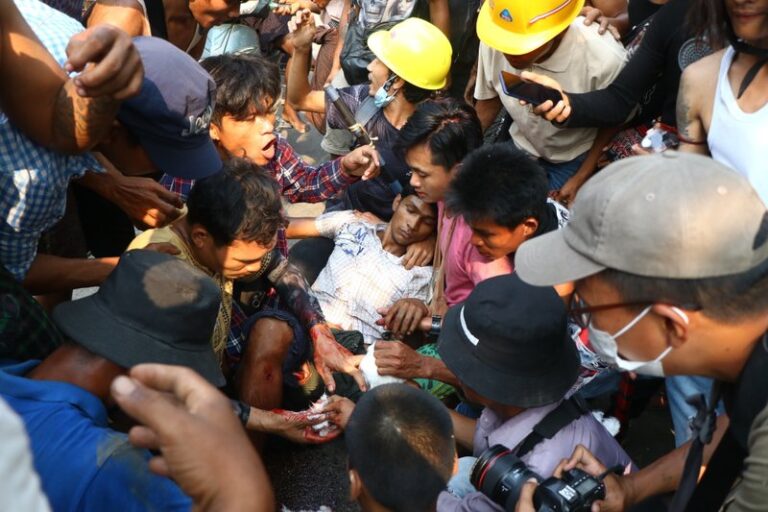
(AP) — Myanmar’s ruling junta has declared martial law in parts of the country’s largest city as security forces killed more protesters in an increasingly lethal crackdown on resistance to last month’s military coup.
At least 38 people were killed Sunday and dozens were injured in one of the deadliest days of the crackdown, according to the Assistance Association for Political Prisoners, an independent group tracking the toll of the violence.
Most of those killed — 34 — were in Yangon, where two townships, Hlaing Thar Yar and neighboring Shwepyitha were being placed under martial law.
Video from Hlaing Thar Yar township showed people running away after gunfire was heard. Those fleeing carried one injured person and tried to revive two others, one who seemed to be dead or dying, the footage from independent Democratic Voice of Burma showed.
Hlaing Thar Yar was the location of 22 civilian deaths Sunday, according to the aid group, which said more than a dozen civilians were wounded and described a large number of junta forces engaged in the township.
Since the takeover six weeks ago, Myanmar has been under a nationwide state of emergency, with its civilian leaders ousted and detained and military leaders in charge of all government. But the announcement on state broadcaster MRTV late Sunday appeared to be the first use of the term martial law since the coup and suggested more direct military control of security, instead of local police.
The announcement said the State Administrative Council acted to enhance security and restore law and order and said the Yangon regional commander has been entrusted with administrative, judicial and military powers in the area under his command.
Four other deaths were reported in Bago, Mandalay, and the northern city of Hpakant in Kachin state, according to the aid group and local media.
In Yangon, video posted on social media showed crowds of people, some wearing hard hats and gas masks, running down a street amid sounds of gunfire. The demonstrators quickly sprayed vapor from fire extinguishers as they retreated — a tactic widely used to smother tear gas and create a vapor screen that makes it harder for police to pursue or shoot demonstrators.
There were also reports of injuries from live rounds and rubber bullets in other parts of Yangon, including Insein district, where billows of black smoke could be seen after security forces reportedly set roadblocks on fire.
In a new tactic, anti-coup demonstrators used the cover of darkness to hold mass candlelight vigils Saturday and Sunday nights in a Yangon commercial area that was usually the scene of their daytime protests. After-dark rallies were also held in Mandalay and elsewhere.
The protest movement has been grounded in non-violent civil disobedience from the start, with marches and general strikes among its main features. But some protesters have advocated stronger, more agile methods of self-defense — such as holding small rallies that are quick to disband and reunite, and devising cover from fire extinguishers and billowing laundry.
On Saturday, the civilian leader of Myanmar’s government in hiding vowed to continue supporting a “revolution” to oust the military leaders who seized power in the Feb. 1 coup. Mahn Win Khaing Than, who was named the acting vice president by Myanmar’s ousted lawmakers and is a member of deposed leader Aung San Suu Kyi’s political party, addressed the public for the first time since the coup.
“This is the darkest moment of the nation and the moment that the dawn is close,” he said in a video posted on the shadow government’s website and social media.






